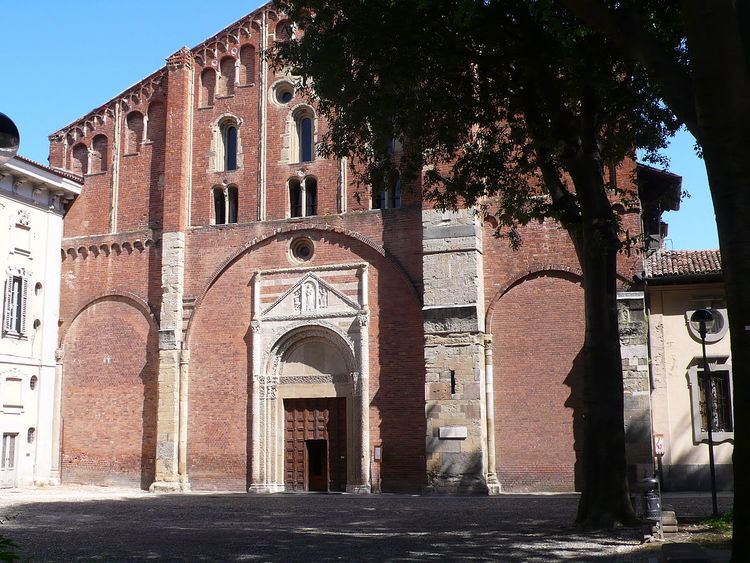Website Homepage | Founded Before 604 (604) Consecrated 1132 Phone +39 0382 303036 Status Basilica | |
 | ||
Similar San Michele Maggiore, Statua della Minerva, Pavia Cathedral, Castello Visconteo, Ponte Coperto | ||
Pavia basilica di san pietro in ciel d oro
San Pietro in Ciel d'Oro (Italian for "Saint Peter in Golden Sky") is a Roman Catholic basilica (and a former cathedral) of the Augustinians in Pavia, Italy, in the Lombardy region. Its name refers to the mosaics of gold leaf behind glass tesserae that formerly decorated the ceiling of the apse. The plain exterior is of brick, with sandstone quoins and window framing. The paving of the church floor is now lower than the modern street level of Piazza San Pietro in Ciel d'Oro, which lies before its façade.
Contents
- Pavia basilica di san pietro in ciel d oro
- Chiesa di san pietro in ciel d oro pavia
- History
- Cultural impact
- References
Chiesa di san pietro in ciel d oro pavia
History
A church of Saint Peter is recorded in Pavia in 604; it was renovated by Liutprand, King of the Lombards (who is buried here) between 720 and 725. The present Romanesque church was consecrated by Pope Innocent II in 1132.
The church is the resting place for the remains of Augustine of Hippo, who died in 430 in his home diocese of Hippo Regius, and was buried in the cathedral there, during the time of the Vandals. According to Bede's True Martyrology, the body was removed to Cagliari, Sardinia by the Catholic bishops whom the Arian Vandal Huneric had expelled from north Africa. Bede tells that the remains were subsequently redeemed out of the hands of the Saracens there— by Peter, bishop of Pavia and uncle of the Lombard king Liutprand— and deposited in the church of Saint Peter about the year 720.
In January 1327 Pope John XXII issued the papal bull Veneranda Santorum Patrum, in which he appointed the Augustinians guardians of the tomb of Augustine (the Arca di Sant'Agostino), which was remade in 1362 and elaborately carved with bas-reliefs of scenes from Augustine's life. The actual remains of Augustine, however, were no longer identified. Then, illiterate stonemasons working in the crypt altar removed paving blocks and discovered a marble box. Within it were other boxes; in the third box were fragments of wood, numerous bones and bone fragments, and glass vials. Some of the workers later claimed to have seen the name "Augustine" written in charcoal on the top of the box. A factor complicating the authentication of the remains was that San Pietro in Ciel d'Oro was shared by the two Augustinian religious orders in bitter rivalry. The controversy on the authenticity of the bones resulted in broadsides, pamphlets and books.
The Augustinians were expelled in 1700, taking refuge in Milan with the relics of Augustine, and the disassembled Arca, which were removed to the cathedral there. The erstwhile cathedral in Pavia fell into disrepair; it was a military magazine under the Napoleonic occupation. It was not reconstructed until the 1870s, under the urging of Agostino Gaetano Riboldi, later Cardinal Riboldi, and reconsecrated in 1896 when the relics of Augustine and the shrine were once again reinstalled.
Cultural impact
Besides being the burial place of Liutprand and Augustine, San Pietro in Ciel d'Oro contains in its crypt that of Boethius, whose Consolation of Philosophy is often taken as the final literary production of Late Antiquity. Dante mentions this in Il Paradiso, canto X:
Lo corpo ond’ella fu cacciata giace
giuso in Cieldauro; ed essa da martiro
e da essilio venne a questa pace
("The body whence it was chased forth / lieth down below in Cieldauro and itself from martyrdom / and exile came unto this peace.")
Boccaccio's Decameron features a chapter (tenth day, ninth novella) that takes place in the basilica: the sumptuous bed of Thorello, soundly sleeping, is magically transported to San Pietro in Ciel d'Oro, where the sacristan discovers him at Matins the following morning.
